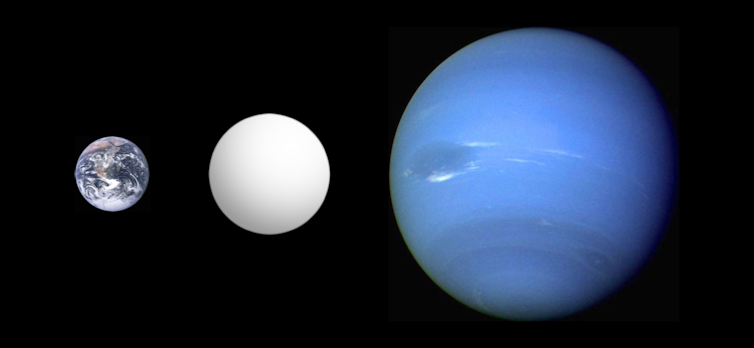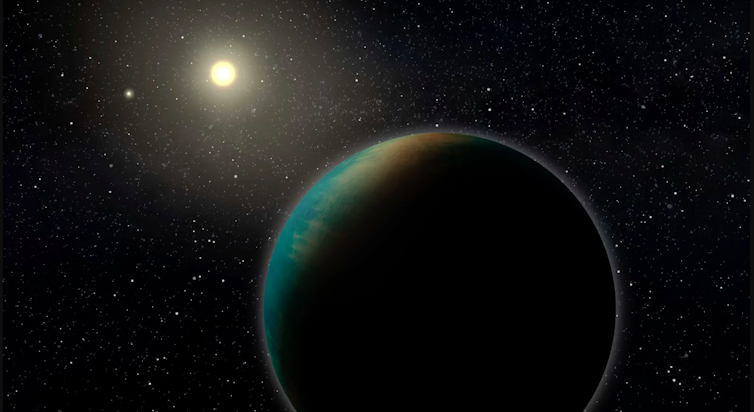Key Takeaways:
- Super-Earths are rocky planets bigger than Earth but smaller than Neptune. They are the most common exoplanet in the Milky Way.
- Super-Earths are easier to find than Earth-sized planets because their size makes them cause a bigger dip in their star’s brightness as they transit.
- Super-Earths may be more habitable than Earth. Their larger size may lead to more active geology and a thicker atmosphere, both factors potentially beneficial for life.
- Astronomers are looking for biosignatures in super-Earths’ atmospheres to search for evidence of life.
- Finding life on super-Earths would be significant. If not found, it might suggest life on Earth is a rare occurrence.
These days, astronomers frequently find planets known as exoplanets circling stars outside of our solar system. However, a few particularly intriguing planets orbiting in the habitable zones of their parent stars were discovered by teams working on NASA’s Transiting Exoplanet Survey Satellite.
One planet orbits its star in less than three days, and it is 30% larger than Earth. The other may have a deep ocean because it is 70% larger than Earth. Super-Earths, such as these two exoplanets, are smaller than ice giants like Neptune and Uranus but have masses greater than Earth’s.
As an astronomy professor, I research exoplanets, astrobiology, distant galaxies, and galactic cores. I keep a close eye on the hunt for potential habitable planets.
As far as scientists are aware, life only exists on Earth and nowhere else in the universe. It would seem sense to concentrate the hunt for life on planets that are similar to Earth in nature, or Earth clones. However, studies have indicated that the greatest possibility for astronomers to discover life on a planet is probably on a super-Earth like the ones that have recently been discovered.

Common and easy to find
Cool dwarf stars, which have a lower mass and a longer lifespan than the Sun, are the stars that most super-Earths orbit. For every star like the Sun, there are hundreds of cool dwarf stars. Of these, 40% have been found to orbit super-Earths by scientists. Based on that figure, astronomers calculate that the Milky Way alone contains tens of billions of super-Earths in habitable zones where liquid water can exist. Since water is necessary for all life on Earth, it is believed that water is essential for habitability.
Super-Earths are the most common type of exoplanet in the Milky Way, accounting for about one-third of all exoplanets according to current projections. The closest one to Earth is just six light-years away. As our solar system lacks a planet with a mass in between that of Earth and Neptune, one could even argue that it is unique.

Super-Earths are also much easier to find and study than Earth-sized planets, which makes them prime targets in the hunt for life. Astronomers find exoplanets using two different techniques. In one, a planet’s gravitational pull on its parent star is detected, while in the other, a star’s light briefly dims as a planet passes in front of it. Both of these detection methods are easier with a bigger planet.
Super-Earths are super habitable
Earth is the “best of all possible worlds,” according to German philosopher Gottfried Wilhelm Leibniz, who made this claim more than 300 years ago. Although Leibniz’s argument was intended to answer the question of why evil exists, modern astrobiologists have investigated a related topic by examining what conditions are necessary for a planet to support life. As it happens, Earth is not the greatest world that could exist.
Over time, the climate has fluctuated from being scorching hot over the ocean to being extremely cold throughout the planet due to tectonic activity on Earth and variations in Sun brightness. For the majority of Earth’s 4.5 billion years of existence, humans and other larger creatures have been unable to live there. Simulations suggest the long-term habitability of Earth was not inevitable, but was a matter of chance. Literally, humans are fortunate to be alive.
Earth is the “best of all possible worlds,” according to German philosopher Gottfried Wilhelm Leibniz, who made this claim more than 300 years ago. Although Leibniz’s argument was intended to answer the question of why evil exists, modern astrobiologists have investigated a related topic by examining what conditions are necessary for a planet to support life. As it happens, Earth is not the greatest world that could exist.
Over time, the climate has fluctuated from being scorching hot over the ocean to being extremely cold throughout the planet due to tectonic activity on Earth and variations in Sun brightness. For the majority of Earth’s 4.5 billion years of existence, humans and other larger creatures have been unable to live there. Simulations suggest the long-term habitability of Earth was not inevitable, but was a matter of chance. Literally, humans are fortunate to be alive.
Scientists have compiled a list of characteristics that make a planet ideal for life. Scientists believe that larger planets would encourage biological evolution because they are more likely to have active geological processes. Therefore, the most habitable planet would be between 20% and 30% larger by volume and have about twice the mass of Earth. It would also have oceans with average temperatures of 77 degrees Fahrenheit (25 degrees Celsius) and shallow enough light to support life all the way to the seafloor. It would have an atmosphere that serves as an insulating blanket and be thicker than Earth’s. Finally, such a planet would orbit a star older than the Sun to give life longer to develop, and it would have a strong magnetic field that protects against cosmic radiation. Scientists think that these attributes combined will make a planet super habitable.

Detecting life on super-Earths
Super-Earths are by definition planets with many of the characteristics of super-habitable planets. Astronomers have found twenty-eight super-Earth exoplanets so far, which are theoretically more habitable than Earth, if not the best of all possible worlds.
There has been a noteworthy addition to the list of planets that are habitable recently. Exoplanets that have been ejected from their star systems are being found by astronomers, and it’s possible that billions of them are out there in the Milky Way. A super-Earth with a watery surface and a thick atmosphere that is expelled from its star system may be able to support life for tens of billions of years—much longer than Earthly life could before the Sun dies.
Astronomers will search for biosignatures—byproducts of biology that can be found in a planet’s atmosphere—in order to identify evidence of life on far-off exoplanets.
The next generation of massive ground-based telescopes, which includes the 39-meter Extremely Large Telescope, the 30-meter Telescope, and the 25.4-meter Giant Magellan Telescope, will have the best chance of discovering life in exoplanet atmospheres. By the end of the decade, all of these telescopes—which are currently undergoing construction—will be gathering data.
Although astronomers are aware that life is possible, habitable does not imply inhabited. Until extraterrestrial life is discovered, it remains possible that life on Earth is an unique accident. While there are many reasons why a habitable world would not have signs of life, if, over the coming years, astronomers look at these super habitable super-Earths and find nothing, humanity may be forced to conclude that the universe is a lonely place.


